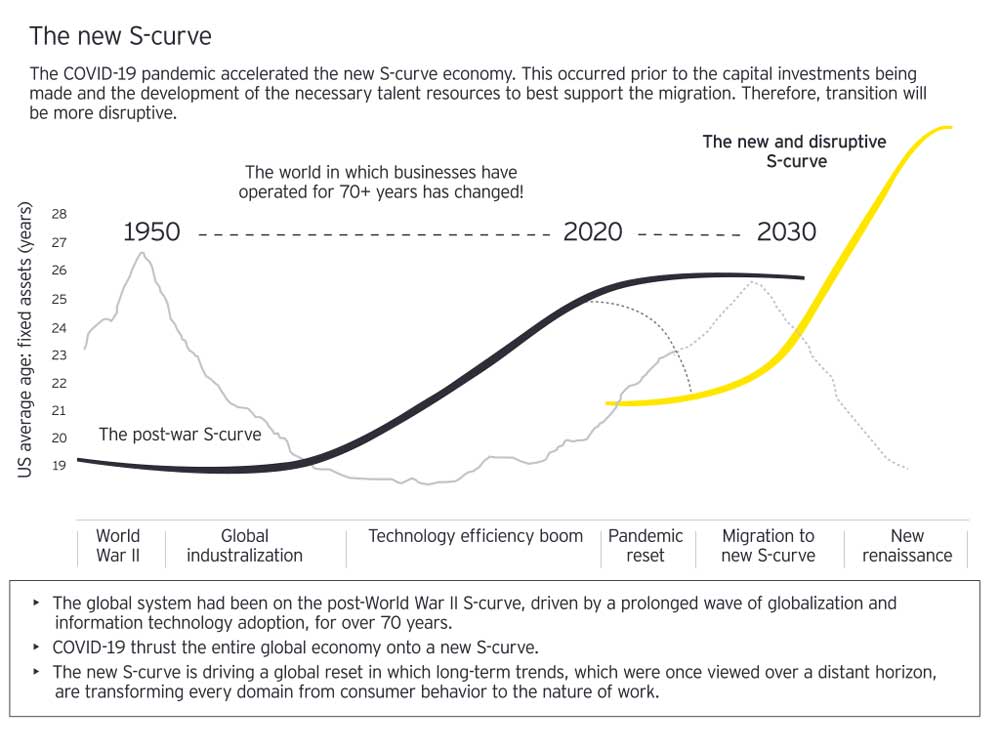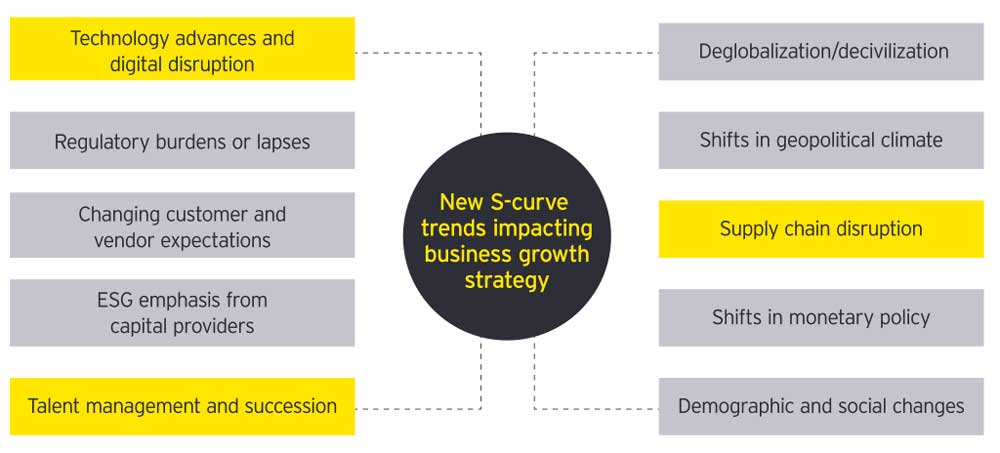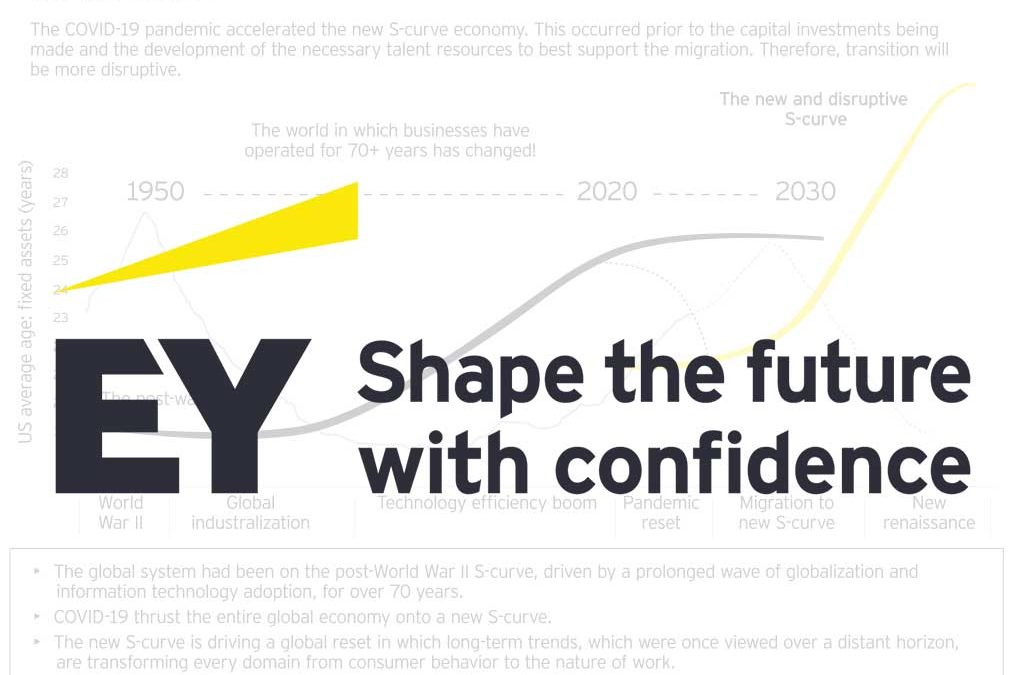Family businesses are operating in a new economic environment that requires rethinking business strategy to deliver ongoing growth and profitability.
In brief:
- To grow over the long term, family businesses need to reexamine their strategic positioning within a rapidly changing business environment.
- Awareness of new S-curve trends, including supply chain disruption, exponential technologies and talent constraints, are creating a new competitive arena.
- Businesses should refocus strategic planning and reassess needed capabilities for growth to avoid interference from the new S-curve and related megatrends.
The extent and speed of change are now upending long-held assumptions about global economics, competitive environments and business models. This is especially relevant for family businesses, whose owners wish to build businesses for the long term. Since the pandemic, almost unnoticed, a new economic S-curve has replaced the post-World War II S-curve.

It is now accelerating and bringing new challenges that affect the growth or profitability for many family businesses. While the challenges will be different for any given company, it’s clear that family businesses are now operating in a world that requires a reexamination of strategic priorities to avoid disruption, remain competitive and to fulfill their owners’ long-term ambitions.
“Family businesses that act now to address macroeconomic and operational changes in their strategic planning will be better positioned to support increased resilience and sustainable growth,” says Bobby Stover, EY Americas Family Enterprise and Family Office Leader.
Disruptive trends

Three key S-curve trends
Although a business growth strategy should account for any of the relevant new S-curve challenges, many family enterprises are assessing these three trends to more effectively compete in a rapidly changing world.
- Supply chain disruption. Deglobalization, growing geopolitical unrest and tightening international trade regulations are impacting businesses and their ability to compete and maintain reliable supply chains. Such trends are forcing countries and regions to consider shifting where their goods are made or to better secure their food and energy sources, which can require choosing new suppliers or trading partners.
Restrictive tariffs, embargoes, import/export regulations, and the threat of conflict in regions that produce key minerals, raw materials and component parts critical to the manufacture of domestic products present a challenge to businesses in forecasting and planning efficient supply chain operations.
- Technological advances and digital disruption. The advances and convergence of exponential technologies including generative artificial intelligence (GenAI), machine learning (ML) and other new technologies have introduced faster, more cost-efficient automation tools and robotics to streamline repetitive and time-consuming tasks with accuracy and efficiency. These new technologies are disrupting business-owning families through the reshaping of consumer behavior, use of automation and artificial intelligence, digital transformation, cybersecurity concerns, and industry-specific technological advancements. These disruptions present both challenges and opportunities, requiring businesses to understand, adapt, innovate and embrace technological advancements.
GenAI and ML algorithms enable businesses to automate various processes, reducing human intervention, while robotics has facilitated physical automation, allowing for repetitive and labor-intensive (and often dangerous) tasks to be performed with greater speed, accuracy and consistency. Further, data-driven decision-making that uses AI platforms to analyze vast amounts of data and identify patterns, trends and insights that humans may not easily detect will be required to remain competitive.
Assessing how automation can be harnessed to augment human capabilities, retrain employees for higher-value tasks, overhaul or streamline businesses processes, and ensure a smooth transition for their workforce in the face of technological disruptions will be required to remain competitive in today’s rapidly evolving business landscape.
- Talent management and succession. Changing demographics, including the reshoring of jobs at the time of a retiring baby boomer workforce, the US population migration and shifting generational preferences have an impact on the availability of talent — and their expectations. Technology advancements and evolving job requirements to meet the enterprise’s future competitive and strategic needs have also created a widening skills and experience gap.
To remain competitive for talent, family businesses should prioritize establishing a strong employer brand, providing opportunities for employee development and advancement, cultivating a positive work culture with a focus on employee engagement and retention, embracing flexible work arrangements, nurturing a strong leadership pipeline through training and cross-functional experience, and seeking continuous feedback and adaptation. By prioritizing these actions, businesses can attract and retain top talent while enhancing their competitive advantage in the market and driving long-term success.
Four tips to adapt to new S-curve trends
Refocusing the traditional strategic planning process to emphasize the impact of new S-curve trends can equip family enterprise leaders for these challenges and others, while helping their businesses to endure and stay in the family for generations.
- Assess current capabilities. As part of the strategic planning process, it’s important to assess your current capabilities relative to the rapidly changing environment and your future aspirations. By examining the enterprise’s strengths and weaknesses, you will be better able to determine what skills and resources are required to meet your future aspirations. Make certain that persons involved in your strategic planning process are using the right internal and external data to form their vision.
- Mitigate supply chain disruption. Examine your supply chain risk with an understanding of challenges posed by deglobalization, regulatory barriers and geopolitical threats. Consider shortening and/or diversifying the supply chain to mitigate the impact of supplier-related risks and develop a more reliable and resilient supply chain.
- Understand and leverage new technology. Determine what skills or resources may be enhanced or augmented by adopting new technologies while retraining employees for higher-value tasks. These can include GenAI tools, software and robotics, such as algorithms and ML techniques, to automate processes and remain competitive.
- Develop talent and plan for succession. Make sure your business and operational governance systems are focused on implementing flexible talent management and training systems that oversee the entire employee lifecycle and work-life balance, from recruitment to performance management, professional development and succession leadership. These systems can support retention and prepare leadership for periods of transition.
Cultivating a more valuable and resilient family enterprise in the new S-curve environment is required for ongoing business growth and minimized disruption. In turn, developing a business growth strategy to meet these challenges starts with assessing your current capabilities relative to your future aspirations, using relevant data when examining the enterprise’s strengths and weaknesses, and determining what skills, resources and technological tools will be required for future aspirations to be realized. With that information, a family enterprise can clarify strategic priorities, opportunities and challenges and build an action plan that can help achieve increased resilience and sustainable growth.
Contact Bobby.Stover@ey.com to learn more.
Article is here: How family businesses can cultivate resilient growth | EY – US

About EY
EY exists to build a better working world, helping to create long-term value for clients, people and society and build trust in the capital markets.
Enabled by data and technology, diverse EY teams in over 150 countries provide trust through assurance and help clients grow, transform, and operate.
Working across assurance, consulting, law, strategy, tax and transactions, EY teams ask better questions to find new answers for the complex issues facing our world today.
EY refers to the global organization, and may refer to one or more, of the member firms of Ernst & Young Global Limited, each of which is a separate legal entity. Ernst & Young Global Limited, a UK company limited by guarantee, does not provide services to clients. Information about how EY collects and uses personal data and a description of the rights individuals have under data protection legislation are available via ey.com/privacy. EY member firms do not practice law where prohibited by local laws.
About EY Family Enterprise
As trusted advisors to ambitious business-owning families, including more than 90% of the world’s top 500 family enterprises, EY teams have the experience and know-how to support the entire family enterprise — family members, their family business, and their family office.
The EY approach to working with family enterprises is anchored in the EY Family Enterprise DNA Model. This model supports both the personal and business performance agendas of family enterprise leaders by pinpointing four key areas of focus to achieve their ambitions: family, values, business and assets. We combine our understanding of these focus areas with decades of experience working with the world’s most entrepreneurial families to create a framework for guided conversations on topics that matter most to family enterprise owners.
EY Family Enterprise professionals can support you in identifying and optimizing the drivers that impact family businesses’ growth and longevity, preserve wealth, and culture, and solidify intergenerational legacies. Family Enterprise Business Services | EY - US
We hope you've enjoyed this article. While you're here, we have a small favor to ask...
As we prepare for what promises to be a pivotal year for America, we're asking you to consider becoming a member.
The need for fact-based reporting of issues important to family owned businesses and protecting a lifetime of savings has never been greater. Now more than ever, successful families and family owned businesses are under fire. That's why Family Enterprise USA is passionately working to increase the awareness of issues important to family owned businesses built on hard work, while continuing to strengthen our presence on Capitol Hill. The issues we fight for or against with Congress in Washington DC include high income tax rates, possible elimination of valuation discounts, increase in capital gains tax, enactment of a wealth tax, and the continued burden of the gift tax, estate tax and generation skipping tax.
Family Enterprise USA promotes generationally owned family business creation, growth, viability, and sustainability by advocating for family businesses and their lifetime of savings with Congress in Washington DC. Since 2007, Family Enterprise USA has represented and celebrated all sizes, professions and industries of family-owned enterprises and multi-generational employers. It is a bi-partisan 501.c3 organization. Family foundations can donate.
#incometax #CapitalGainsTax #R&DExpensing #DontPunishSuccess #GrantorTrusts #StepUpinBasis #likeKindExchanges #AcceleratedDepreciation #EstateTax #Deathtax #wealthtax #taxLegislation #CongressionalCaucus #incometaxrates #repealestatetax #AdvocatingForFamilyBusinesses #FamilyOwnedBusiness #WomenOwnedBusiness @FamilyEnterpriseUSA #FamilyEnterpriseUSA #FEUSA

